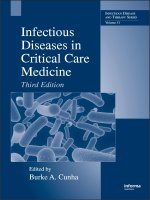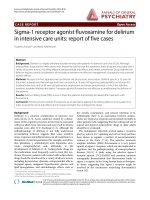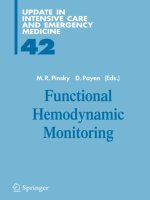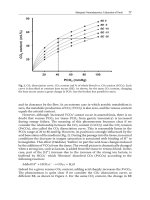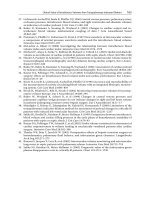4 OSCE in intensive care medicine (jul 1, 2015) (1910079235) (tfm publishing)
Bạn đang xem bản rút gọn của tài liệu. Xem và tải ngay bản đầy đủ của tài liệu tại đây (3.73 MB, 252 trang )
•
1n
lt nte ~nsive
Care
Me ~di ~cine
Objective Structured
Clinical Examination
In
Intensive
Care
Medicine
tfmPublishingLimited,CastleHillBarns,Harley,Shrewsbury,SY56LX,UK
Tel:+44(0)1952510061;Fax:+44(0)1952510192
E-mail:
Website:www.tfmpublishing.com
Editing,design&typesetting:NikkiBramhillBScHonsDipLaw
Firstedition:©2016
Paperback
E-bookeditions:
ePub
Mobi
Webpdf
ISBN:978-1-910079-23-2
2016
ISBN:978-1-910079-24-9
ISBN:978-1-910079-25-6
ISBN:978-1-910079-26-3
TheentirecontentsofObjectiveStructuredClinicalExaminationinIntensiveCareMedicineis
copyrighttfmPublishingLtd.Apartfromanyfairdealingforthepurposesofresearchorprivate
study,orcriticismorreview,aspermittedundertheCopyright,DesignsandPatentsAct1988,
thispublicationmaynotbereproduced,storedinaretrievalsystemortransmittedinanyform
orbyanymeans,electronic,digital,mechanical,photocopying,recordingorotherwise,without
thepriorwrittenpermissionofthepublisher.
Neither the authors nor the publisher can accept responsibility for any injury or damage to
personsorpropertyoccasionedthroughtheimplementationofanyideasoruseofanyproduct
described herein. Neither can they accept any responsibility for errors, omissions or
misrepresentations,howsoevercaused.
Whilst every care is taken by the authors and the publisher to ensure that all information and
datainthisbookareasaccurateaspossibleatthetimeofgoingtopress,itisrecommended
that readers seek independent verification of advice on drug or other product usage, surgical
techniquesandclinicalprocessespriortotheiruse.
The authors and publisher gratefully acknowledge the permission granted to reproduce the
copyrightmaterialwhereapplicableinthisbook.Everyefforthasbeenmadetotracecopyright
holders and to obtain their permission for the use of copyright material. The publisher
apologizesforanyerrorsoromissionsandwouldbegratefulifnotifiedofanycorrectionsthat
shouldbeincorporatedinfuturereprintsoreditionsofthisbook.
PrintedbyCambrianPrinters,LlanbadarnRoad,Aberystwyth,Ceredigion,SY233TN
Tel:+44(0)1970627111;Website:www.cambrian-printers.co.uk
Contents
Preface
Abbreviations
Interpretingastandardelectrocardiogram(ECG)
Acknowledgements
Dedication
Chapter1
Acuterespiratorydistresssyndrome(ARDS)
Cardiacoutputmonitoring
Tracheostomyemergency
CorticosteroidsintheICU
Bloodproducttransfusion
Diabeticketoacidosis
Professionalism—criticalincidentreporting
Equipment
Community-acquiredpneumonia
Guillain-Barrésyndromeandplasmapheresis
Electrocardiography—set1
Radiology—set1
Chapter2
Capnography
Hepaticfailureandascitictap
Compartmentsyndrome
Intra-aorticballoonpump
Delirium
Infectiveendocarditis
Disseminatedmalignancy
Professionalism—faileddischarge
Lumbarpuncture
Localanaesthetictoxicity
Electrocardiography—set2
Radiology—set2
Chapter3
Burns
Myastheniccrisis
Equipment
Necrotisingfasciitis
Paracetamoloverdose
Professionalism—refusaloftreatment
Pleuraleffusion
Acuterespiratorydistresssyndrome(ARDS)
Panton-Valentineleukocidin(PVL)pneumoniaandantibiotics
Renalreplacementtherapy
Electrocardiography—set3
Radiology—set3
Chapter4
Rhabdomyolysis
Professionalism—NGtubeinthelung
Acutepancreatitis
Pulmonaryinfiltrates
Septicshockandfluids
Refeedingsyndrome
SIADH,cerebralsaltwastingandDI
Subarachnoidhaemorrhage
Tetanus
Equipment
Electrocardiography—set4
Radiology—set4
Chapter5
Trauma—massivebloodtransfusion
Stroke
Trauma—diaphragmaticrupture
Thromboticthrombocytopaenicpurpurainpregnancy
TraumaticbraininjuryandmanagementofraisedICP
Warfarin
Tumourlysissyndrome
Professionalism—omissionoflow-molecular-weightheparin
Brainstemdeathtesting
Abdominalcompartmentsyndrome
Dermatology—toxicepidermalnecrolysis
Viralhaemorrhagicfever—Ebola
Index
Preface
ObjectiveStructuredClinicalExaminations(OSCEs)inmedicinearenotanewphenomenon.
Intensivecareexamsacrosstheworldarenowincorporatingthisformofexaminationaspart
of the assessment process. Take for example the Fellowship of the Faculty of Intensive Care
Medicine (FFICM) examination in the United Kingdom (UK) which now includes OSCEs; thus,
theyaregainingfurtherimportance.
Thereareanumberofintensivecaremedicine(ICM)textbooksavailable,buttherearevery
fewresourcesspecificallyaimedatthepracticeofOSCEsinICM.Thisbookisnotdesignedto
beatextbook;rather,ithasbeenspecificallydesignedtoimplementtherehearsalofOSCEs.
Much like a driving test there are certain things in the OSCEs that must be said to score that
everpreciousmark,evenifitisstatingtheabsoluteobvious,forexample:
ThisisacriticalemergencyandIwouldundertake:
•
An acute assessment, resuscitation and management to follow an ‘airway, breathing, circulation,
disabilityandexposure’approach.
Small and compact in design, this book can be utilised for practice in the immediate days
runninguptoanICMexam.Previousexamtopicfavouriteshavebeencarefullyanalysedbefore
the preparation of this book. It will aid the reader to polish their OSCE performance and
possiblyidentifyareasthatmayhavebeenneglected.
Dependingontheexamthatyouwillsit,afairproportionofquestionswillrequireanswersin
the form of lists (e.g. list of tests you would order). In our experience this often leads to the
examiner repeating the phrase “anything else?”! Try not to get thrown by this; you may have
given an excellent answer but there is still a further mark for the one thing you didn’t mention
andtheexamineristryingtogiveyoutheopportunitytoscorethatfinalmark!Nomatterhow
good your knowledge is, everyone forgets something in the heat of the exam! The OSCE
answersandnarrativesinthebookhavebeenpurposelyarrangedasbulletedliststimedfor6minutestations.ThisisbecauseeverystationinanOSCEexamhaslistedscoringmarkswhich
are available in that finite time of 6 minutes. With practice, your ‘OSCE mindset’ can be
arrangedsoastoscoremarksinasystematicandorganised,yetswift,manner.Forexample,
inthischestX-ray,whataresomeofthecausesofbilateralpulmonaryinfiltrates?:
•Pulmonaryoedema:
-cardiacfailure;
-valvularheartdisease—congenitaloracquired;
-renalfailure;
-liverfailure;
-iatrogenicfluidoverload.
•Infection:
-bacterial;
-viral;
-fungalorprotozoal;
•Autoimmune:
-Goodpasture’ssyndrome;
-pulmonaryfibrosis.
•Acuterespiratorydistresssyndrome(ARDS).
(4 marks — 1 mark for each correct main stem with appropriate substemexamples.)
Yourbrainshould‘sieve’outtheusefulinformationinthesesituations,toensurethatyouare
atleastscoringmarksindifferentorgansystems.Inthisexample,itisentirelypossibletostate
“ARDS” and “pulmonary oedema”, and then waste precious time trying to state causes in a
haphazard manner. The practice of answering as an organised bulleted list allows important
markstobescored,whilstsavingtimetopickupfurthermarksinothersubsequentquestions.
Scoring systems have come up in past OSCE exams, hence many of the important ones
havebeenincorporatedintothechapters.
Rememberthatifyouaresittinganexamwithavivaelement,thereisthepossibilityoftopic
cross-over from the OSCE to the viva and vice versa. To that aim, when using this book, it is
worth trying to outline how you would answer the OSCE topic were you given it in a viva
setting.
Simulation stations can form a station in ICM OSCEs. We have made a conscious decision
nottoincludethemintheOSCEsetspresentedhere,ashigh-fidelitysimulationisverydifficult
toemulatethroughabook.Insteadwehaveprovidedadditionalstationswhichcouldwellform
thebasisofasimulationstation.
We have included ‘Top Tip’ boxes to provide clues as to what the examiners are looking for
and what they are expecting from your answers. These tips have been assembled from the
principal knowledge and experience of candidates who have undertaken ICM exams, hence
theyarewellworthnoting.
You will be examined in at least one of the so-called ‘professionalism’ stations, colloquially
referredtoas‘communicationskills’stations,duringtheexamination.Commonly,theseinvolve
theuseofactors,ratherthanpatients,andyouneedtodevelopastrategyfordealingwiththe
‘method’ actor who takes their role too seriously. Colleagues of ours have often expressed
frustrationwhenthe‘daughter’ofthesimulatedpatientspentsomuchtimecryingthatitproved
very difficult to progress with the station. Unfortunately, we have no magic formula for this
occurrence, but highlighting the possibility of it happening will give you an opportunity to try to
workoutastrategytodealwiththis.Theprofessionalismstationswehaveincludedinthisbook
dooftenreadalittlelikealist;unfortunately,wecan’t find any other way of introducing these
typesoftopics.Youwillneedtorelyonyour‘sparringpartner’toembellishthesestationsinto
something that resembles the OSCE station. The station gives you the topic and a standard
markingschemebutyouwillneedacolleaguetoroleplaytheactor’spart.
Itisnotuncommonforthesameorsimilartopicstocomeupinthesameexam,especiallyif
theyaredeemedimportant,thoughasquestionbanksincreaseinsizethisislessofanissue.If
it does happen make sure you listen in case the focus of the question is different, and be
thankful.
Thereareanumberofmore‘formulaic’stationsandwehaveattemptedtoprovideasystem
toanswerthese.Themostcommonoftheseisthedreadedelectrocardiogram(ECG)station.
Our advice would be to decide on your system of interpreting and presenting an ECG (we’ve
outlinedoneverysimplemethodinthebook).EvenifyouhavenoideawhattheECGshows,
youwillbeatleastscoringmarksasyougothroughitsystematically.Whenpresentedwiththe
nextECGdothesame;theexaminerwillmostlikelytellyouiftheydonotwantyoutodothis
again,inwhichcaseifyoudon’tknowthediagnosisyouwillstruggle.Inourconversationswith
examiners,thereareoftenmarksforthissystematicapproach,sodon’tmissout.
ThisisunlikelytobethefirstOSCEthatyouhavesatinyourmedicalcareer,soremember
thatalltherulesyoulearntatmedicalschoolstillapply.Ifyouhaveabadstation,forgetitand
moveon.Ifyoudon’tknowtheanswertoaquestionandtheexaminerisfailingtomoveonthen
tellthem!Moststationsaredesignedtoallowyoutoscoremarks,evenifyoufailtoscorethe
markforthediagnosis.
Whilst both authors have been through the UK intensive care training programme, we have
triedhardtominimiseanypossiblebiastowardsexaminationsintheUKandEurope,inorderto
achieveamoreglobalappeal.Thus,thebookisrelevantforanyICMexaminationthatcontains
anOSCEelement.ForthoseofyoutakingEuropean-basedexams,wehavehadcontactwith
examiners for the European Diploma in Intensive Care Medicine (EDIC), as well as the newly
createdFellowshipoftheFacultyofIntensiveCareMedicine(FFICM)intheUK.Manyofthese
stationsarebasedonrealtopicswhichhavecomeupinbothofthesetwoexaminationsover
the last few years; however, we have been careful to try and remove any European
eccentricities,especiallywithrespecttoacronyms!Assuchweareconfidentthatthisbookwill
proveanexcellenttrainingtoolforanyICMexamwhichemploystheOSCEformat.
Wewishyouthebestofluckwiththeexamyouareabouttotakeandlookforwardtoseeing
well-thumbedcopiesofthisbookonthenurses’stationinintensivecareunits(ICUs)acrossthe
country! We want the book to be a resource for colleagues to hone their skills for an OSCE
format.Thebookshouldbetheperfectwayofpackingin10minutesofOSCErevisionbefore
thenextICUwardroundstarts!
JeyasankarJeyanathanBMedSci(Hons)MBBSDMCCPgCert(MedSim)FRCAFFICM
DanielOwensBSc(Hons)MBBSPgCert(MedEd)FRCAFFICM
IntensiveCareUnit,StGeorge’sHospital,London,UK
Abbreviations
ABG
Ach
ACS
ACTH
ADH
AF
AFB
AKI
ALP
ALT
AMTS
AP
aPTT
ARDS
AST
AVN
BAL
BC
BDS
BE
BMI
BNP
BP
BTS
Ca
CAM-ICU
CAP
CCF
CCS
CI
CK
ClcmH2O
CMV
CO2
CO
COPD
CPAP
Arterialbloodgas
Acetylcholine
Abdominalcompartmentsyndrome
Adrenocorticotropichormone
Antidiuretichormone
Atrialfibrillation
Acid-fastbacillus
Acutekidneyinjury
Alkalinephosphatase
Alanineaminotransferase
AbbreviatedMentalTestScore
Anteroposterior
Activatedpartialthromboplastintime
Acuterespiratorydistresssyndrome
Aspartateaminotransferase
Atrioventricularnode
Broncho-alveolarlavage
Bloodculture
BritishDiabetesSociety
Baseexcess
Bodymassindex
B-natriureticpeptide
Bloodpressure
BritishThoracicSociety
Calcium
ConfusionAssessmentMethodfortheIntensiveCareUnit
Community-acquiredpneumonia
Congestivecardiacfailure
Corticosteroid
Cardiacindex
Creatinekinase
Chloride
Centimetresofwater
Cytomegalovirus
Carbondioxide
Cardiacoutput
Chronicobstructivepulmonarydisease
Continuouspositiveairwaypressure
CPP
CPR
CRP
CSF
CSWS
CT
CVA
CVP
CVVDF
CVVHDF
CVVHF
CXR
DDAVP
DI
DIC
DKA
DO2I
DVT
EBV
ECG
ECMO
EGDT
ELISA
ERCP
ESR
ETCO2
ETT
EVD
FBC
FFP
FIB
FiO2
FRC
GCS
GGT
GI
GTN
Hb
HES
HFOV
HHS
HITTS
HR
Cerebralperfusionpressure
Cardiopulmonaryresuscitation
C-reactiveprotein
Cerebrospinalfluid
Cerebralsaltwastingsyndrome
Computedtomography
Cerebrovascularevent
Centralvenouspressure
Continuousveno-venousdiafiltration
Continuousveno-venoushaemodiafiltration
Continuousveno-venoushaemofiltration
ChestX-ray
Desmopressin
Diabetesinsipidus
Disseminatedintravascularcoagulation
Diabeticketoacidosis
Oxygendeliveryindex
Deepveinthrombosis
Ebstein-Barrvirus
Electrocardiogram
Extracorporealmembraneoxygenation
Earlygoal-directedtherapy
Enzyme-linkedimmunosorbentassay
Endoscopicretrogradecholangiopancreatography
Erythrocytesedimentationrate
End-tidalcarbondioxide
Endotrachealtube
Externalventriculardrain
Fullbloodcount
Freshfrozenplasma
Fasciailiacablock
Fractionalconcentrationofinspiredoxygen
Functionalresidualcapacity
GlasgowComaScale
Gamma-glutamyltranspeptidase
Gastrointestinal
Glyceryltrinitrate
Haemoglobin
Hydroxyethylstarch
High-frequencyoscillatoryventilation
Hyperglycaemichyperosmolarstate
Heparin-inducedthromboticthrombocytopenicsyndrome
Heartrate
HTLV
IABP
IABP
IAH
IAP
ICM
ICP
ICU
IE
INR
IV
IVDU
IVIg
K+
kPa
LA
LBBB
LDH
LFT
LIDCO
LMWH
LSCS
LVOT
MAHA
MAP
MCA
MCH
MCHC
MC&S
MCV
MET
Mg
MI
mmHg
MRCP
MRI
MRSA
Na+
NAP4
NDL
NG
NICE
NIHSS
HumanT-celllymphotrophicvirus
Invasivearterialbloodpressure
Intra-aorticballoonpump
Intra-abdominalhypertension
Intra-abdominalpressure
Intensivecaremedicine
Intracranialpressure
Intensivecareunit
Infectiveendocarditis
InternationalNormalisedRatio
Intravenous
Intravenousdruguse
Intravenousimmunoglobulin
Potassium
KiloPascals
Localanaesthetic
Leftbundlebranchblock
Lactatedehydrogenase
Liverfunctiontest
Lithiumdilutioncardiacoutputmonitoring
Low-molecular-weightheparin
LowersegmentCaesareansection
Leftventricularoutflowtract
Microangiopathichaemolyticanemia
Meanarterialpressure
Middlecerebralartery
Meancorpuscularhemoglobin
Meancorpuscularhemoglobinconcentration
Microscopy,cultureandserology
Meancorpuscularvolume
Metabolicequivalent
Magnesium
Myocardialinfarction
Millimetresofmercury
Magneticresonancecholangiopancreatography
Magneticresonanceimaging
Methicillin-resistantStaphylococcusaureus
Sodium
NationalAuditProject4
Non-directedlavage
Nasogastric
NationalInstituteforHealthandCareExcellence
NationalInstitutesofHealthStrokeScale
NSAID
NSTEMI
Non-steroidalanti-inflammatorydrug
Non-ST-segmentelevationmyocardialinfarction
OSA
PA
PA
PCI
PCR
PCV
PE
PEEP
PMN
PRBC
PT
PVL
RAP
RASS
RBBB
RBC
RCC
RCT
RDW
Obstructivesleepapnoea
Pulmonaryartery
Posteroanterior
Percutaneouscoronaryintervention
Polymerasechainreaction
Packedcellvolume
Pulmonaryembolism
Positiveend-expiratorypressure
Polymorphonuclearcells
Packedredbloodcells
Prothrombintime
Panton-Valentineleukocidin
Rightatrialpressure
RichmondAgitationSedationScale
Rightbundlebranchblock
Redbloodcell
Redcellcount
Randomisedcontrolledtrial
Redcelldistributionwidth
Rotationalthromboelastometry
Renalreplacementtherapy
Rapidsequenceinduction
Recombinanttissueplasminogenactivator
Subarachnoidhaemorrhage
Sinoatrialnode
Arterialoxygensaturation
Spontaneousbacterialperitonitis
Centralvenousoxygensaturation
Syndromeofinappropriateantidiuretichormonesecretion
Systemicinflammatoryresponsesyndrome
Systemiclupuserythematosus
Sinusrhythm
SurvivingSepsisCampaign
ST-segmentelevationmyocardialinfarction
Strokevolume
Superiorvenacava
Systemicvascularresistance
Systemicvascularresistanceindex
Strokevolumevariation
Traumaticbraininjury
Totalbodysurfacearea
ROTEM®
RRT
RSI
r-tPA
SAH
SAN
SaO2
SBP
ScvO2
SIADH
SIRS
SLE
SR
SSC
STEMI
SV
SVC
SVR
SVRI
SVV
TBI
TBSA
TEG®
TEN
Thromboelastography
Toxicepidermalnecrolysis
TLS
TOE
TRALI
TT
TTE
TTP
U&Es
US
VATS
VC
VHF
WCC
Tumourlysissyndrome
Transoesophagealechocardiogram
Transfusion-relatedacutelunginjury
Thrombintime
Transthoracicechocardiography
Thromboticthrombocytopaenicpurpura
Ureaandelectrolytes
Ultrasound
Video-assistedthoracoscopicsurgery
Vitalcapacity
Viralhaemorrhagicfever
Whitecellcount
Interpretingastandardelectrocardiogram(ECG)
Top
Tip
Paperspeed
25mm/sec
Standardvoltage
10mm/mV
Eachsmallsquare
0.04seconds
Fivesmallsquares
0.2seconds
Twenty-fivesmallsquares
1second
Wavesandintervals:
P-waveduration
0.06-0.12seconds
1-3smallsquares
PRinterval
0.12-0.2seconds
3-5smallsquares
QRScomplexduration
0.06-0.10seconds
1-3smallsquares
QTinterval
0.36-0.44seconds
CorrectedQT(QTC)=Bazett’sformula=
QTinterval/√(RRinterval)
RRinterval=60/HR
0.44seconds
A suggested structure for rapid presentation of an ECG in the
OSCEscenarioispresentedbelow.TryandpresentallyourECGs
inasetsystematicmannerinthelead-uptotheexam,asthiswill
allowsimplemarksnottobemissedintheheatofyourbattle!
•
•
•
•
•
•
Rate—60beatsperminute.
Rhythm—sinusrythm.
Axis—leftaxis(-1100).
P-wave morphology and P-R interval — normal morphology,
prolongedPR.
QRScomplex—broad.
ST segments — ST depression seen in V2, V3 (but note you
•
•
•
•
cannotcommentonthiswithbundlebranchblock).
T-wavemorphology—T-waveinversionV1.
QTinterval—normal.
Is there bundle branch block? — right bundle branch block
(RBBB).
Otherspecialnotes—Q-wavesinII,IIIaVF.
Acknowledgements
Wegratefullyacknowledgethefollowingsources:
Chapter1
Figure1.4.Emergencytracheostomymanagement.©JohnWileyandSons,2012.
McGrath BA, Bates L, Atkinson D, Moore JA. Multidisciplinary guidelines for the management
oftracheostomyandlaryngectomyairwayemergencies.Anaesthesia2012;67(9):1025-41.
UKNationalTracheostomySafetyProject;www.tracheostomy.org.uk.
Figure1.5.Emergencylaryngectomymanagement.©JohnWileyandSons,2012.
McGrath BA, Bates L, Atkinson D, Moore JA. Multidisciplinary guidelines for the management
oftracheostomyandlaryngectomyairwayemergencies.Anaesthesia2012;67(9):1025-41.
UKNationalTracheostomySafetyProject;www.tracheostomy.org.uk.
Figure1.6.©DrJeremyJones.
Radiopaedia.org.
Figure1.12.AlgorithmforthemanagementofCAP.©BritishThoracicSociety,2009.
/>
Chapter2
Figure2.12.©iStock.com/stockdevil.
.
Chapter3
Figure3.2.Dr.KennethGreer.VisualsUnlimited.©GettyImages.
.
Figure 3.4. British Thoracic Society Pleural Disease Guideline. © British Thoracic Society,
2010.
/>
Chapter4
Figure4.3..
Figure4.6.©C.R.BardInc.,2015.
Dedication
Tothemanyteacherswhotookthetimetoteachandguide
us — thank you very much. We hope that we too can
contribute to this crucial continuation in medical education
andtraining.
To our beautiful and beloved families, this book is
testament to their tireless support, patience and love. We
dedicatethisbooktoyou.
JeyasankarandDaniel
Chapter1
Acuterespiratorydistresssyndrome(ARDS)
You are the intensive care medicine doctor on-call when you are asked to
helpwithapatientthatthenurseisfinding‘difficult’toventilate.Thepatient
is a 45-year-old man admitted with pancreatitis 3 days ago. He was
intubated on admission and his oxygen requirements have been increasing
overthelast24hours.
1)
•
You are shown the following arterial blood gas (ABG) ( Table 1.1).
Commentonthebloodgas.
2marks(1
markforeach
correctstem)
Thereisevidenceof:
•
•
Hypoxiaandhypercarbia.
Amixedrespiratoryandmetabolicacidosis.
2)
Whatinvestigationswouldyouorder?
•
•
ChestX-ray
Echocardiogram.
Full blood count (FBC), urea and electrolytes (U&Es), liver function tests
(LFTs),B-natriureticpeptide(BNP).
C-reactiveprotein(CRP).
•
•
2marks(0.5
markforeach
correctstem,
withamaximum
of2marks)
•
3)
Microbiological samples, e.g. sputum/broncho-alveolar lavage (BAL)/nondirectedlavage(NDL).
•
You are shown the following chest X-ray (CXR) ( Figure 1.1).
CommentonthisCXR.
2marks
Figure1.1.
Therearethefollowingsalientfeatures:
•
•
Anendotrachealtubeinsitu.
Bilateralpulmonaryinfiltratesofa‘ground-glass’appearance.
4)
Whatarethedifferentialdiagnoses?
•
•
•
•
•
•
•
•
•
•
Acuterespiratorydistresssyndrome(ARDS)(secondarytothepancreatitis).
Autoimmunelungdisease,e.g.Goodpasture’ssyndrome.
Infection(bacterial,viralorfungal).
Transfusion-relatedacutelunginjury(TRALI).
Pulmonaryfibrosis.
Pulmonaryhaemorrhage.
Interstitialoedema.
Pneumocystisjiroveciipneumonia(PJP)infection.
Cardiacfailureorvalvularheartdisease.
Toxicshocksyndrome.
4marks(1
markforeach
correctstem,
withamaximum
of4marks)
5)
Whatotherkeyimagingwouldyourequest?
•
CTofthechest.
6)
Commentonthisscan( Figure1.2).
1mark
•
2marks
Figure1.2.
•
•
Thereisground-glassshadowingwithbilateralpleuraleffusions.
ThisisconsistentwithARDS.
7)
Howwouldyouventilatethispatient?
TheARDSnetventilatorystrategiesshouldbeimplemented1:
•
•
Tidalvolumes6-8ml/kgidealbodyweight.
Plateaupressure<30cmH2O.
•
Positiveend-expiratorypressure(PEEP)titratedtoFiO2.
•
Permissivehypercapnia.
8)
Thepatientcontinuestodeteriorate.Whatotherstrategieswithproven
positive evidence are there to improve severe ARDS and refractory
hypoxia?
The following strategies have supporting current evidence in improving the
outcomeinsevereARDScases:
4marks(1
markforeach
correctstem)
3marks(1
markforeach
correctstem)
•
Prone positioning of the patient. There was an improved mortality in severe
ARDSasrecentlyshowninthePROSEVAtrial2.
•
Musclerelaxationorparalysis.TheACURASYStrialfoundanimprovementin
mortalitywiththeearlyimplementationofacisatracuriuminfusionincasesof
severeARDS3.
•
Extracorporeal membrane oxygenation (ECMO). The CESAR trial
demonstratedanimprovementinoxygenationinpatientswithsevereARDS4.
Top
Tip
TheOSCEexamwilloftenaskfora‘list’ofanswers;forexample,
please list some causes, differential diagnoses, specific
investigations, etc. It is important to recognise that time is a
precious commodity and that the list needs to be produced in a
succinct and swift manner. In order to help with this it is well
worth having a system to organise your answer and in the days
approaching the exam to practice these systems in producing
answers. For example, in the question above on listing some
differential diagnoses for the CXR, a simple system could be
utilisingtheclassicsurgicalsieve,‘VITAMINC’,orusingthebody
systemstolistpotentialcauses.Sointhisexamplethecausesfor
thisCXRcouldbeorganisedassuch:
•
•
•
•
•
•
•
•
Vascular—pulmonaryinfarctionorcongestivecardiacfailure.
Iatrogenic — fluid overload from excessive blood product or
intravenousfluidadministration.
Traumatic—pulmonarycontusions.
Autoimmune — Goodpasture’s syndrome, severe sarcoid
diseaseorsystemiclupuserythematosus(SLE).
Metabolic.
Infectiveorinflammatory:
– infective causes subclassified as bacterial, viral, protozoal
or fungal. In this case many organisms could have
precipitatedsuchachestradiograph;
– inflammatorycauses—ARDS.
Neoplastic.
Congenital.
References
1.
2.
3.
4.
/>Ventilator%20Protocol%20Card.pdf.
Guerin C, Reignier J, Richard JC, et al. Prone positioning in severe acute
respiratorydistresssyndrome.NEnglJMed2013;368:2159-68.
Papazian L, Forel JM, Gacouin A, et al. Neuromuscular blockers in early
acuterespiratorydistresssyndrome.NEnglJMed2010;363:1107-16.
Peek GJ, Clemens F, Elbourne D, et al. CESAR: Conventional Ventilatory
Support vs. Extracorporeal Membrane Oxygenation for Severe Adult
RespiratoryFailure.BMCHealthServicesResearch2006;6:163.
Cardiacoutputmonitoring
Thisstationwillexploredifferentaspectsofcardiacoutputmonitors.
1)
•
Whatformofcardiacmonitoringdoesthispicturerepresent( Figure
1.3)?
1mark
Figure1.3.
This is a screen-shot of the information derived from a cardiac output
monitor:
•
•
2)
Pulsecontourwaveanalysis.
Specificallylithiumdilutioncardiacoutputmonitoring(LIDCO).
•
Below are some values from a cardiac output monitor ( Table 1.2).
Pleasesummarisetheinformationandexplainwhatthisindicates.
6marks
Keypointsinsummary:
•
•
•
Theheartrateislow.
The patient is hypotensive in spite of a high systemic vascular resistance
(SVR).
Thecardiacoutput(CO)indicesarealllowwithalowoxygendelivery.
Keypointsintheexplanation:
•
•
•
3)
•
•
4)
•
•
•
TheCOislowasaresultofalowheartrateorfilling.
TheraisedSVRwillcontributetoaraisedafterloadincreasingtheworkofthe
heartandpotentiallydecreasingtheCO.
The CO is low for this body’s surface area as the oxygen delivery is
compromisedaswell.
Whataretheprinciplesofpulsewaveformcontouranalysis?
1mark
Anarterialwaveformtracecanbeanalysedwithinthecontextofthepatient’s
heartrate,weightandheight.
Stroke volume (SV) is proportional to the area under the curve up to the
dicroticnotch.
Whichvaluesaremeasuredandwhicharecalculated?
Information that can be directly measured include the heart rate (HR), blood
pressure(BP)andmeanarterialpressure(MAP).
InformationthatcanbecalculatedincludetheSVandCO.
Informationthatcanbederivedincludethecardiacindex(CI),oxygendelivery
index(DO2I)andsystemicvascularresistanceindex(SVRI).
2marks(1
markforeach
correctstem,
withamaximum
of2marks)
5)
Whataresomeofthemanagementoptionsorstrategiesthatcouldbe
employedforthispatienttoimprovecardiacoutput?
•
Increasetheheartrate.
•
•
Improveintravascularfillingand,hence,venousreturnwhichmayimprovethe
MAP.
ImprovetheafterloadbydecreasingtheSVR.
6)
This patient has an SVV of 18%. What is the SVV and what
managementstrategycouldbeundertakenbasedonthisinformation?
•
•
•
Strokevolumevariation(SVV)isamarkeroffluidresponsiveness.
ItisthepercentagechangeinSVthatoccursduringtheventilatorcycle.
ThenormalSVVis5-10%.
•
•
•
Fluidchallengesofapproximately150-250mlofIVfluidcouldbegivenwhich
shouldimprovecardiacpreload.Thismaybetransient.
If an improvement in SVV and SV are seen then a further fluid challenge
shouldbeundertaken.
Fluid challenges should continue to be given until the SVV no longer
responds.
7)
Listsomeothercardiacoutputmonitors.
•
•
•
•
•
OesophagealDoppler.
Otherpulsecontouranalysistools—LIDCO,PICCO.
Pulmonaryarterycatheter.
Transthoracicechocardiogram.
Transoesophagealechocardiogram.
8)
With regard to oesophageal Doppler, what unique values can be
derivedfromitandwhatdotheyrepresent?
•
•
Peakvelocity—anindicationofventricularcontractility.
Flowtimecorrected—durationofflowduringsystole.Thisisanindicatorof
preloadorafterload.
References
1.
Chamos C, Vele L, Hamilton M, Cecconi M. Less invasive methods of
advanced hemodynamic monitoring: principles, devices, and their role in the
perioperativehemodynamicoptimization.PerioperMed2013;2:19.
3marks(1
markforeach
correctstem)
3marks(0.5
markforeach
correctstem)
2marks(0.5
markforeach
correctstem,
withamaximum
of2marks)
2marks
